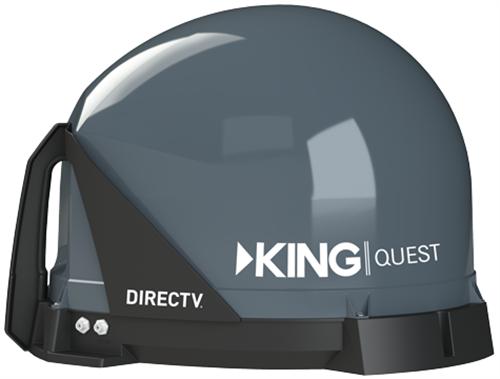This is a common myth that we at Solid Signal run into. A lot of people say that you can’t get HD programming using a small portable satellite system like the KING Quest you see above. Actually, they can. It’s just that there aren’t any HD channels to get. Let me back up a little bit.
KING’s portable satellite products give you satellite TV almost anywhere. Just put it on a level surface with a clear view of the southern sky and it will do the rest. There’s only one problem though… you’ll only get standard definition channels. A lot of people will tell you that the dish can only see the 101 satellite, and that’s not exactly true. It’s mostly true, but the reasoning behind it is a little different than you might think.
Digging deep into the reasons why
DIRECTV uses two different sets of frequencies for satellite transmissions. One, the “Ku band,” is the same set of frequencies used by satellite TV operators all over the world, including DISH. The other, the “Ka band,” between 26.5 and 40GHz, is only used by DIRECTV in North America. No one else has any licenses for it. While this means virtually limitless capacity for HD and 4K channels, it also means that instead of off-the-shelf parts, a DIRECTV satellite dish needs special receiving equipment. On regular dishes something like the Slimline 5 Legacy Reverse Band LNB is used which gives one dish the ability to receive Ku-band broadcasts from three locations and Ka-band broadcasts from two others. It even packages all that signal up into a nice tidy chunk of frequencies that can all fit on one wire.
Yeah but
It’s worth pointing out that while a system like that can technically receive signals from thr 110 and 119 satellite locations, there probably isn’t anything there you can actually receive. The 110 satellite has been decommissioned. The last satellite at the 119 location has a handful of local standard definition channels but that’s it. So yes, it’s fair to say that Ku band is only used at the 101 satellite location at this point.
Why portable satellite dishes only get the Ku band
For mobile dishes, that big LNB wouldn’t fit and it wouldn’t focus the signals the way it needs to. In order to receive most DIRECTV HD broadcasts, which are on the Ka band, you’d need a custom-manufactured LNB that was small enough to work in a portable dish. Custom hardware is expensive, and at the moment none of the makers of mobile and marine antennas are spending that money. At the very least you would need a custom Ka-band tuner chip, and if you only had that you would lose SD channels (potentially not a big deal.) If you wanted it all, you’d need a custom-made setup like that SWM LNB but smaller and designed to work with a smaller dish. All that costs a lot of money and it would change the price a lot.
As DIRECTV continues to consolidate its programming on its three main satellites and gets rid of standard definition programming, I fully expect to see more HD programs at that 101 location. There are currently about five HD channels on the 101 satellite. That satellite is the most modern in DIRECTV’s fleet. It’s likely that they could fit 100 HD channels on it if they wanted to. I personally think they’ll want to. Moving channels to the Ku band will make rain fade even less common. It will also let DIRECTV continue to offer service to airlines and other companies with long-term contract.
Of course no one really knows the future
I do expect that folks with portable dishes will get more HD programs in the next few years. It’s going to mean your investment is even more valuable. However, I have to admit that I don’t know for sure. DIRECTV’s plans are confidential, limited to a small number of folks in their El Segundo, CA offices. Those folks aren’t talking.
If you want to know the latest and greatest news, call the experts! No one is more knowledgeable about RV satellite TV than Signal Connect. We’ve been activating satellite TV for RVs for over 20 years. If there’s info out there, we’ll know it. Give the experts a call at 888-233-7563 to find out the latest news. We’re here for you during East Coast business hours. If it’s after hours, no problem! Fill out the form below. We’ll get right back to you!





